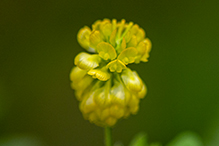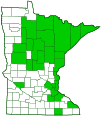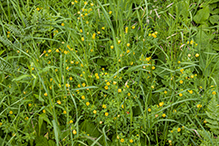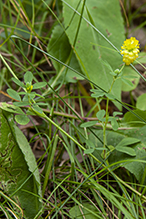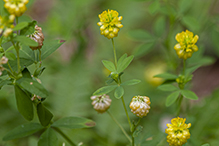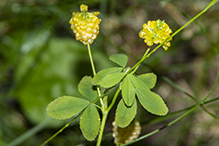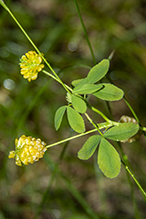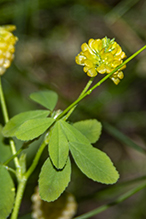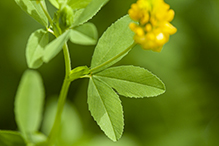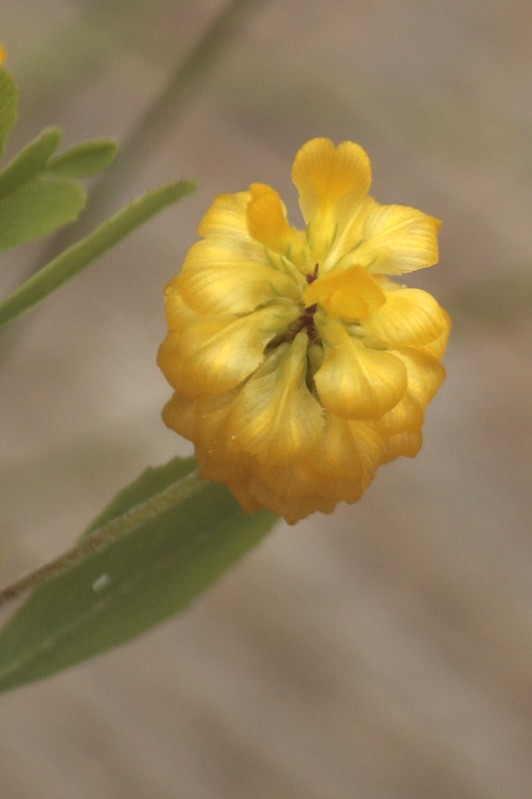golden clover
(Trifolium aureum)
Conservation • Description • Habitat • Ecology • Use • Distribution • Taxonomy
Conservation Status |
|
|||||||
| IUCN Red List | not listed |
|||||||
| NatureServe | NNA - Not applicable SNA - Not applicable |
|||||||
| Minnesota | not listed |
|||||||
Description |
||
Golden clover is native to Europe and Asia. It was introduced into North America in the eighteenth century and cultivated. According to one source*, George Washington ordered seeds of this species from Europe in 1786. It eventually escaped cultivation and it is now naturalized. It occurs in the United States in the east from Maine to Minnesota south to North Carolina and Missouri, in the west from Washington to Montana, and in adjacent Canadian provinces. In Minnesota it is common in the northeast and north-central regions, scattered in the metro and southeast, and mostly absent elsewhere. Golden clover is an 8″ to 20″ tall, annual or biennial forb that rises on one to several stems from a taproot. It often forms colonies. The stems are erect or ascending, often much branched, and covered with short appressed hairs. They do not root at the nodes. The leaves are alternate though they may sometimes appear opposite on flowering branches. They are on leaf stalks (petioles) that can be 3 ⁄16″ to ½″ (5 to 12 mm) long but are always shorter than the leaflets. The petioles get gradually shorter as they ascend the stem. At the base of each petiole there is a pair of conspicuous, persistent, leaf-like appendages (stipules) that are about as long or slightly longer than the petiole. The stipules are oblong lance-shaped, prominently veined, and fused at the base to the petiole for about half their length. The free half of each stipule is narrow and long tapered to the tip. The leaves are divided into 3 leaflets, all of them stalkless. The leaflets are papery thin, ⅜″ to ⅞″ (10 to 23 mm) long, and 3 ⁄16″ to 5 ⁄16″ (5 to 8 mm) wide. The leaflet blades may be inversely egg-shaped, inversely lance-shaped, or elliptical. They are tapered to the base and rounded or broadly and bluntly pointed at the tip. They are sometimes shallowly notched at the tip, and there is sometimes a short, sharp, abrupt point at the tip. There is a prominent midvein and 10 to 18 pairs of lateral veins. The upper and lower surfaces are usually hairless. The margins are untoothed below the midpoint, finely toothed above the midpoint. The inflorescence is single, dense, globe-shaped or short cylinder-shaped clusters of 25 to 40 overlapping flowers rising from upper leaf axils. Each cluster is ⅜″ to ¾″ (10 to 20 mm) long, ½″ to 9 ⁄16″ (12 to 14 mm) wide, and at the end of a hairy ⅜″ to 2″ (10 to 15 mm) long stalk (peduncle). The peduncle is as long or longer than the cluster. Individual flowers are erect when in bud, spreading when in bloom, and drooping when in fruit. Each flower is 3 ⁄16″ to ¼″ (5 to 7 mm) long and on a very short stalk (pedicel). There are 5 sepals, 5 petals, and 10 stamens. The group of sepals (calyx) is light green, small, and inconspicuous. It is fused at the base into a 1 ⁄32″ (0.8 to 1.0 mm) long tube then separated into 5 teeth. The lower teeth are the longest, 2 to 3 times longer than the upper teeth, and 2 or 3 times longer than the calyx tube. The petals are bright yellow and are organized like a typical pea flower, with an upper banner, a pair of lateral wing petals, and a pair of lower keel petals. The banner is broadly inversely egg-shaped and slightly curved inward. It has a broad, shallow notch at the tip. The outer surface is conspicuously veined. The wing petals are dilated and concave. The keel petals are fused along the lower margin and appear as a single folded unit enclosing the stamens and pistil. The petals become brown and papery with age. The stamens have long stalks (filaments) and small anthers. The filaments of nine of the stamens are fused together for most of their length. The tenth stamen is free. The fruit is a narrowly egg-shaped, ⅛″ (2.5 to 3.0 mm) long seed pod containing a single seed. ____________________________ * Yatskievych, George, and Steyermark. 2013. Steyermark’s Flora of Missouri Volume 3; page 149. Jefferson City, Missouri: The Missouri Department of Conservation. |
||
Height |
||
8″ to 20″ |
||
Flower Color |
||
Yellow |
||
Similar Species |
||
Field clover (Trifolium campestre ssp. campestre) stipules are shorter than the petiole and are angled or somewhat tapered at the tip. The leaflets have only 5 to 8 pairs of lateral veins. The terminal leaflet is distinctly stalked. The seed is ellipse-shaped. |
||
Habitat |
||
Old fields, roadsides, open disturbed sites |
||
Ecology |
||
Flowering |
||
May to September |
||
Pests and Diseases |
||
|
||
Use |
||
|
||
Distribution |
||||
|
Sources |
|||
| 4/19/2023 | ||||
Nativity |
||||
Native to Europe and Asia. Introduced and naturalized in North America. |
||||
Occurrence |
||||
Common |
||||
Taxonomy |
|||
| Kingdom | Plantae (Plants) | ||
| Subkingdom | Pteridobiotina | ||
| Phylum | Tracheophyta (Vascular Plants) | ||
| Class | Magnoliopsida (Dicots) | ||
Order |
Fabales (Legumes, Milkworts, and Allies) | ||
Family |
Fabaceae (Legumes) | ||
| Subfamily | Faboideae | ||
| Tribe | Trifolieae |
||
| Genus | Trifolium (Clovers) | ||
| Subgenus | Chronosemium | ||
Subordinate Taxa |
|||
|
|||
Synonyms |
|||
| Trifolium agrarium | |||
Common Names |
|||
golden clover hop clover large hop clover large hop trefoil large trefoil low hop clover palmate hop clover yellow clover yellow hop clover |
|||
The common name hop clover refers to the appearance of the flower heads. After maturity they turn brown and hang downward, resembling hops. |
|||
Glossary
Axil
The upper angle where a branch, stem, leaf stalk, or vein diverges.
Calyx
The group of outer floral leaves (sepals) below the petals, occasionally forming a tube.
Filament
On plants: The thread-like stalk of a stamen which supports the anther. On Lepidoptera: One of a pair of long, thin, fleshy extensions extending from the thorax, and sometimes also from the abdomen, of a caterpillar.
Pedicel
On plants: the stalk of a single flower in a cluster of flowers. On insects: the second segment of the antennae. On Hymenoptera and Araneae: the narrow stalk connecting the thorax to the abdomen: the preferred term is petiole.
Peduncle
In angiosperms, the stalk of a single flower or a flower cluster; in club mosses, the stalk of a strobilus or a group of strobili.
Petiole
On plants: The stalk of a leaf blade or a compound leaf that attaches it to the stem. On ants and wasps: The constricted first one or two segments of the rear part of the body.
Stipule
A small, leaf-like, scale-like, glandular, or rarely spiny appendage found at the base of a leaf stalk, usually occurring in pairs and usually dropping soon.

Visitor Videos |
|||
Share your video of this plant. |
|||
| This button not working for you? Simply email us at info@MinnesotaSeasons.com. Attach a video, a YouTube link, or a cloud storage link. |
|||
Other Videos |
|||

Visitor Sightings |
|||||
Report a sighting of this plant. |
|||||
| This button not working for you? Simply email us at info@MinnesotaSeasons.com. Be sure to include a location. |
|||||
|
|||||
MinnesotaSeasons.com Sightings |
|||||

Created: 12/8/2019
Last Updated:
